Saving Alma Mater
A Rescue Plan for America’s Public Universities
America’s public universities educate 80% of our nation’s college students. But in the wake of rising demands on state treasuries, changing demographics, growing income inequality, and legislative indifference, many of these institutions have fallen into decline. Tuition costs have skyrocketed, class sizes have gone up, the number of courses offered has gone down, and the overall quality of education has decreased significantly.
Here James C. Garland draws on more than thirty years of experience as a professor, administrator, and university president to argue that a new compact between state government and public universities is needed to make these schools more affordable and financially secure. Saving Alma Mater challenges a change-resistant culture in academia that places too low a premium on efficiency and productivity. Seeing a crisis of campus leadership, Garland takes state legislators to task for perpetuating the decay of their public university systems and calls for reforms in the way university presidents and governing boards are selected. He concludes that the era is long past when state appropriations can enable public universities to keep their fees low and affordable. Saving Alma Mater thus calls for the partial deregulation of public universities and a phase-out of their state appropriations. Garland’s plan would tie university revenues to their performance and exploit the competitive pressures of the academic marketplace to control costs, rein in tuition, and make schools more responsive to student needs.
A much-needed blueprint for reform based on Garland’s real-life successes as the head of Miami University of Ohio, Saving Alma Mater will be essential for anyone concerned with the costs and quality of higher education in America today.
296 pages | 7 line drawings, 3 tables | 6 x 9 | © 2009
Economics and Business: Business--Business Economics and Management Studies
Education: Education--Economics, Law, Politics, Education--General Studies, Higher Education
Reviews
Table of Contents
Preface
Acknowledgments
Introduction
Part I: A Primer on Public Higher Education Economics
1 Where the Money Comes From
2 Market Forces in Higher Education
3 Why Public Universities Cannot Restrain Costs
4 The University Prime Directive
Part II: The Academic Culture of Freedom and Waste
5 The Faculty Are the University
6 The Cargo Cult College
7 The Blessing and Curse of Shared Governance
8 What Price Shared Governance?
Part III: Renegotiating the Public Compact
9 The Shape of Things to Come
10 Leadership Begins with the Trustees
11 The Role of Governing Boards in the New Era
12 Recruiting Presidential Leadership
13 Reforming the Academic Culture
14 A Proposal for Deregulation of Public Universities
Postscript
Appendix A: The Miami University Tuition Plan
Appendix B: The Impact of Competition on Public University Tuition, Costs, and Revenue
Appendix C: Suggested Readings
Notes
Index